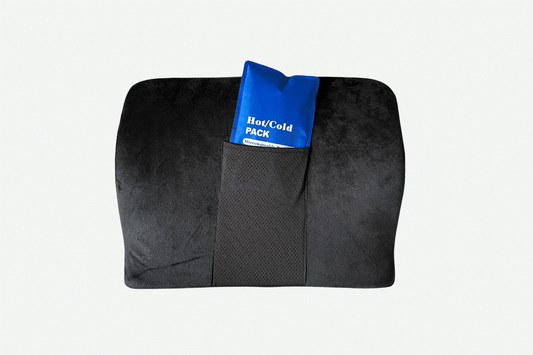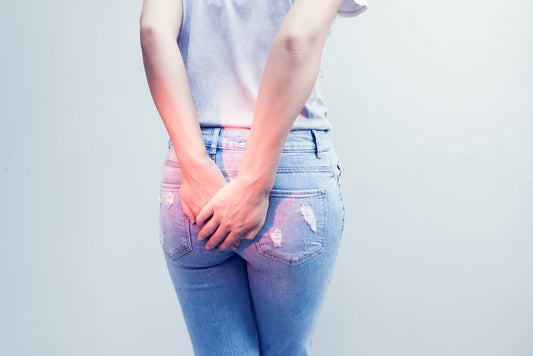How to Treat Diaper Rash (& What Products Prevent Diaper Dermatitis)
Robert Cutler, D.O., FAOCPrShare
Babies go through a lot of diapers, so it should come as no surprise that diaper rash is the most common skin disorder among infants. Even a hint of moisture can be enough to set off bacterial growth, and it’s only a matter of time before that translates to discomfort for you and your baby both. No one wants to see their baby in pain! Keep reading to learn more about what causes diaper rash and strategies for both preventing and treating diaper rash flare-ups at home.
What is Diaper Rash?
Baby’s diaper rash is a condition caused by irritation of the skin, often leading to redness or red splotches in your baby’s genital area. In severe cases, this splotchy rash can turn into scales or sores that spread from the diaper area up into the legs and stomach. Other common rashes that share similar symptoms include eczema, psoriasis, impetigo, and heat rash, though these differ in origin and treatment. Learning what to look for and what causes diaper rash will help you identify how to best help your baby’s diaper rash treatment, as outlined below.
Diaper Rash Causes
Diaper rash is typically the result of irritation, environment or allergy.
- Irritation - Diapers left on too long cause the contents of the diaper (or the diaper itself) to rub against the skin.
- Environment - Contact with urine or stool changes the PH levels of the skin, leading to an environment more susceptible to bacteria or fungal growth. Similarly, the moist environment created by the leak-proof technology of diapers fosters bacterial growth.
- Allergy - There are many hidden chemicals and ingredients in the dyes, wipes, bath products and yes, even diapers that come into contact with a baby’s skin. These can cause an allergic reaction in the form of a rash.
Signs your baby may have diaper rash include the telltale inflamed, pink, red, puffy, tender or itchy skin in the diaper area, and increased fussing or crying when changing their diaper. As soon as you notice these signs, it’s important to know what to do for a diaper rash, as diaper rashes left untreated may result in infection.
Now that we’ve gone over some of the most common causes, here are some tips on how to treat diaper rash.
How to Treat Diaper Rash
We’ll get into more detail on diaper rash prevention later on, but if those efforts fail, it’s good to have a host of at-home diaper rash remedies. While diaper rash may feel unavoidable, there are a number of simple, easy-to-administer home treatments that you can employ at the first sign of irritation.
Home Remedies
Home remedies for how to help diaper rash include the following:
- Warm compress – A warm compress can be administered wet or dry (think dampened towels vs. heating pad). Gently holding it against the skin will increase blood flow to the area while it soothes, quickening the healing process.
- Barrier cream – After thoroughly cleaning the skin following a diaper change, applying a barrier cream will keep the affected area dry while still allowing airflow. Applying a barrier cream over medicated ointments will help protect the skin from further chafing or excess moisture as it heals.
- Air drying – Increasing the skin’s exposure to air encourages healing. This means creating time for your baby with no diapers or creams, using larger diapers while there are still signs of rash and loosely attaching diapers rather than a firm fit.
- Witch hazel – Witch hazel is a natural astringent that cools skin and decreases redness and inflammation. It is a common ingredient in chemical-free ointments and creams or can be applied to the skin with a cotton ball after diluting pure witch hazel with equal parts water.
- Breast milk – The antibodies found in breast milk contain antibacterial properties that are effective in killing off the bacteria that can lead to certain forms of diaper rash. Breast milk also contains healthy fat that will protect the skin.
- Aloe vera – Aloe vera is another natural ingredient with anti-inflammatory and antimicrobial properties. Just as you would apply it to sunburn, placing a small amount of pure aloe vera gel offers relief from the itching and redness caused by diaper rash.
- Shampoo clay – Shampoo clay is another name for bentonite, a mineral that is known for its ability to absorb moisture. Hydrating the clay with water to create a paste or including it as part of a cream to treat diaper rash will effectively keep the inflamed skin dry and relieve itchiness.
Medical Treatments
When at-home methods aren’t showing any signs of improvement, it may be time to try a medicated option. You should immediately seek the advice of a doctor in the event of more severe diaper rash treatment (rashes accompanied by fever, rashes that persist or worsen, bleed or ooze, or cause pain when your baby urinates or has a bowel movement). The type of medication prescribed typically depends on the nature of the rash, be it fungus, bacteria or infection. Find out more on each of these medical options below.
- Prescription creams – Prescribed for diaper rash that is caused by irritation or dermatitis, these are the lowest potency and safest topical steroid creams (containing hydrocortisone or desonide) that target inflammation.
- Antifungal creams – Prescribed for diaper rash that is caused by yeast (candida), antifungal creams (containing nystatin or clotrimazole) bind to and permeate the fungal cell membrane, allowing cellular contents to leak out and destroying the fungal cell in the process.
- Antibiotics – Prescribed only if there are clear signs of infection, antibiotics to cure diaper rash can be administered orally or topically. Topical antibiotic cream (containing bacitracin) kills bacterial cells, and oral antibiotics (containing amoxicillin or clavulanate) target more serious bacterial infections that are resistant to topical treatment.
Diaper Rash Prevention
Diaper rash doesn’t have to be a given, and the following list breaks down easy additions to your baby’s changing and diaper routine that may help nip it in the bum before it has a chance to start.
Changing Diapers Frequently
How often should you change a baby’s diaper is one of the most frequently asked questions by new parents, and the short answer is that it’s different for each baby. Staying on top of your baby’s specific patterns and ensuring that they have as little skin contact as possible with urine and feces will help eliminate a main cause of diaper rash. While diapers are designed to soak up a moderate amount of urine, waiting to change diapers until it’s ‘full’ means a higher risk of leakage. This is particularly important in preventing newborn diaper rash, when the rate of diaper change is at its highest.
Using Disposable or Cloth Diapers That Are Made of Breathable Materials
As surface irritation is the main culprit of diaper rash, the goal for any diaper should be its compatibility with your baby’s skin. Disposable diapers are inherently sanitary, convenient, and designed to remove moisture from your baby’s skin. Cloth diapers offer a cotton-alternative, a lower price point and produce less daily waste. There are pros and cons to both, but whichever diaper you choose should be made of breathable material. Diapers that trap in scent, trap in urine or poop, or diaper covers and liners that trap in moisture all prevent the best defense against skin irritation: air!
Avoiding Harsh Soaps or Detergents
Figuring out what ingredients may irritate your baby’s skin can feel like a guessing game, but there are certain chemicals to avoid right off the bat. Soaps and detergents made specifically for babies typically avoid harsh ingredients like phosphates, parabens, bleach and formaldehyde. Fragrances are another common allergen, and their inclusion as an ingredient can mean a host of hidden chemicals. Hypoallergenic, nontoxic soaps and detergents are a great way to worry about one less diaper rash risk factor.
Introducing Solid Food to Baby Gradually
The introduction of new and solid foods to your baby’s diet is an exciting milestone. It can also mean an increase in their bowel movements and changes to the consistency and content of the stool itself. Combine all of these factors and you have a recipe for diaper rash. Slowly bringing in one new food at a time and observing your baby’s reaction helps ensure you’re on top of any fluctuations in bowel routine. Being aware of the acidity of new foods (tomatoes, citrus) and common triggers for diarrhea (dairy, fruit juice, prunes) will also help you stay on top of instances with high potential for diaper rash.
Keeping the Skin Dry and Clean
Keeping your baby’s skin dry and clean means frequently checking them for leaks, changing diapers right away, patting dry the area once it has been cleaned and allowing the skin time to air out before applying barrier ointment and starting the process all over again. It’s a lot of work, but clean and dry skin is the most straightforward and best defense against diaper rash.
Products That Help Prevent Diaper Rash
In addition to steps in your routine, there are different products that can help prevent diaper rash. Read on to learn what to use for a diaper rash before it starts.
Diaper Creams and Ointments
After completely cleaning and drying your baby’s skin, the next step in diaper rash prevention is applying a cream or ointment that will protect the sensitive area and prevent moisture. A thin covering will act as a barrier, especially if you notice the skin beneath the diaper becoming dry or tender. Again, look out for known irritants frequently found in these products, including synthetic fragrance, petroleum-based synthetics (like vaseline), preservatives and talc.
We make a prevention-focused diaper rash cream that combines medication and natural excipients for a soothing, relieving formula.
Diaper Wipes
Thoroughly cleaning your baby’s bottom after a diaper is soiled is essential to maintaining the delicate pH balance of their skin. Contact with urine and fecal matter increases the risk that the pH will rise, leading to diaper rash and bacterial growth. Wet wipes that are safely designed for a baby’s sensitive skin can help ensure that no remaining mess is left behind. A larger, thicker wipe, like Doctor Butler’s Soothing Organic Baby Wipes, also means you won’t be wiping more than necessary, preventing the friction that can lead to rash.
Keep Your Baby Happy and Healthy with Doctor Butler’s
If there’s one thing we can all associate with babies, it’s diapers, so it’s not shocking that the list of diaper rash prevention methods, home remedies and even medicated treatment options is endless. While it’s always best to see a doctor if you’re unsure or if things don’t improve, this extremely common condition is one that can be tackled head-on using the many strategies recommended above. Developing a babycare routine that focuses on a clean and dry environment and works with your baby’s unique patterns and skin will do wonders for keeping that bottom happy, healthy, and rash-free!


